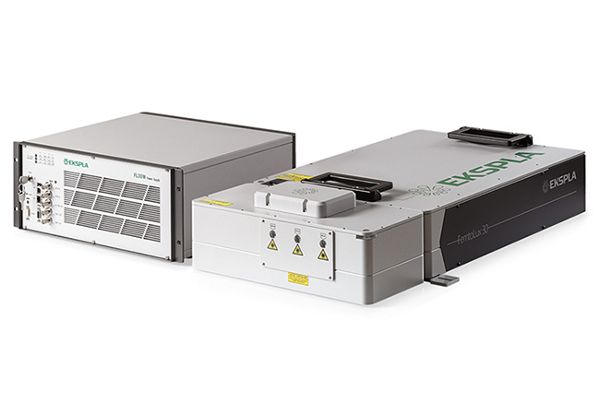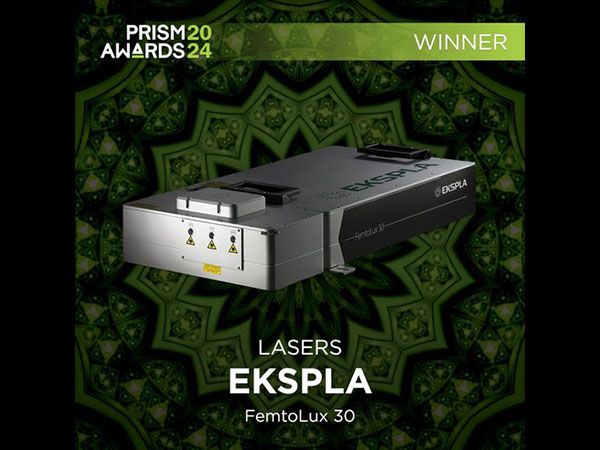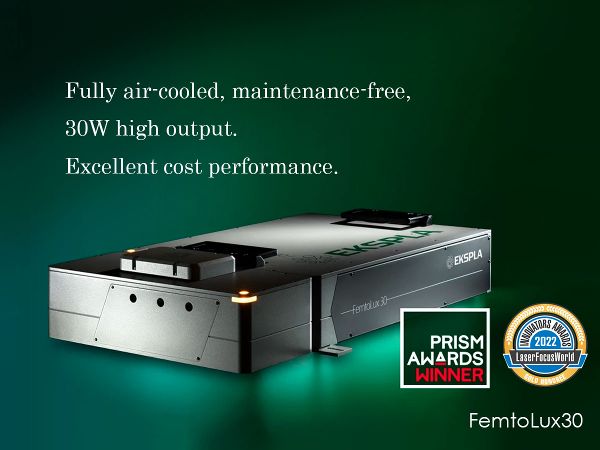

2024 Prizm Award at the SPIE International Conference
At the international conference SPIE, EKSPLA's FemtoLux 30 received the Prizm Award for the best optical and photonics product.
Go to SPIE PRISM AWARDS website
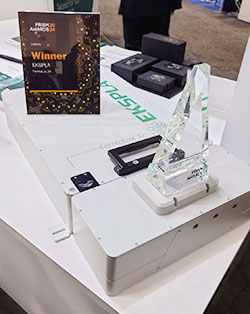
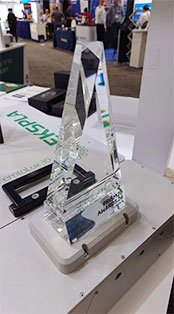
2022 Gold Award at the Laser Focus World Innovators Awards
EKSPLA Receives Gold Award at the 2022 Laser Focus World Innovators Awards The Laser Focus World Paper Innovators Award recognizes technological products that are unique and innovative, and the Femto Lux-30 from EKSPLA was recognized for its unique dry-cooling capability and the benefits it brings to users.
New Feature|GHz Burst Option Long/Short
The Femtolux 30 laser can operate in the single-pulse mode, MHz burst mode and GHz burst mode. The burst formation technique based on the use of the AFL is a very versatile method as it allows to overcome many limitations encountered by other fiber- and/or solid-state-based techniques. The benefits of this technology:
・Any desired intra-burst PRR can be achieved independently from the initial PRR of the master oscillator
・Identical pulse separation inside the GHz bursts is maintained
・Short- and long-burst formation modes can be provided. A short burst is up to about 10 ns burst width (from 2 to tens of pulses in the GHz burst). A long burst is from ~20 ns up to a few hundred ns in burst width (from tens to thousands of pulses in the GHz burst)
・An adjustable amplitude envelope of the GHz bursts is provided
・No pre/post pulses in GHz burst. Pure GHz bursts
・Ultrashort pulse duration is maintained inside the bursts
A new versatile patent-pending method to form ultra-high repetition rate bursts of ultrashort laser pulses. The developed method is based on the use of an all-in-fiber active fiber loop (AFL). A detailed description of the invention can be found on:
1.Andrejus Michailovas, and Tadas Bartulevičius. 2021 Int. patent application published under the Patent Cooperation Treaty (PCT) WO2021059003A1.
2.Tadas Bartulevičius, Mykolas Lipnickas, Virginija Petrauskienė, Karolis Madeikis, and Andrejus Michailovas, (2022), “30 W-average-power femtosecond NIR laser operating in a flexible GHz‑burst-regime,” Opt. Express 30, 36849-36862.
SPECIFICATIONS|Parameter
| Burst repetition rate | 200~650 kHz | |
|---|---|---|
| Intra-burst pulse repetition rate 1) | 2 GHz | |
| GHz BURST MODE | short | long |
| Number of pulses 2) | 2~22 | 44~1100 |
| Shape | square, rising, falling |
falling, pre-shaped 3) |
| MHz + GHz burst mode | ||
| Burst repetition rate | 100~650 kHz | |
| Number of pulses in MHz burst | 2~10 | |
| Number of pulses in GHz burst | 2~22 | |
1.Custom intra-pulse PRR is available upon a request.
2.Depends on the intra-pulse PRR.
3.For more information, please inquire sales@ekspla.com.
SHORT GHZ BURST
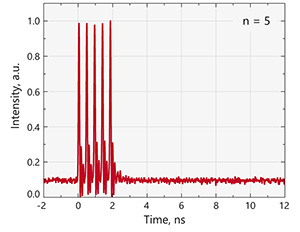
Measured 2.2 GHz intra-burst PRR burst of pulses containing 5 pulses of equal amplitudes at 31.5 W average output power
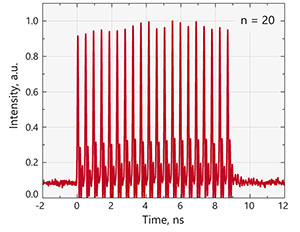
Measured 2.2 GHz intra-burst PRR burst of pulses containing 20 pulses of equal amplitudes at 31.5 W average output power
LONG GHZ BURST
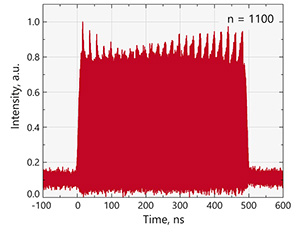
Measured 2.2 GHz pre-shaped bursts of 1000 pulses at 233 kHz burst repetition rate for the desired rectangular-like burst shape
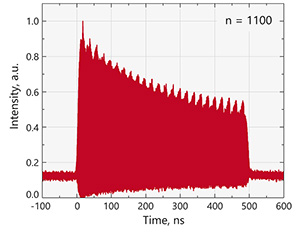
Measured 2.2 GHz non-pre-shaped bursts of 1100 pulses at 233 kHz burst repetition rate
MHZ + GHZ BURST MODE
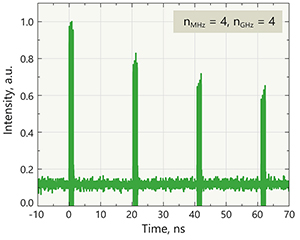
Measured 4 bursts of 50 MHz BRR containing 4 pulses of 2.5 GHz intra-burst PRR
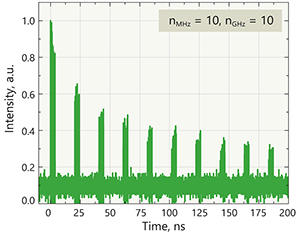
Measured 10 bursts of 50 MHz BRR containing 10 pulses of 2.5 GHz intra-burst PRR
Pulse-on-Demand (PoD)
BENEFITS
- Jitter lower than 20 ns ensures consistent and equidistant pulse spacing for high-speed micromachining
- Adjustable repetition rate for processing complex geometries
- Faster processing speeds, increased productivity
PoD feature enables the laser to fire a pulse only when required, rather than at a constant rate, enabling precise control over the laser’s output and resulting in higher efficiency, accuracy and quality. This capability is especially valuable in various micromachining applications where a high processing speed, constant energy, and accuracy are essential. To follow complex curvature at high speed and to maintain equidistant spacing it is necessary to ensure that the repetition rate of the pulses is adjusted. To achieve these requirements, it is necessary to ensure that the repetition rate of the pulses is adjusted to follow complex curvature at high speed and to maintain equidistant spacing. One may try to use position based laser triggering but, due to laser system limitations, the jitter will be from several μs to tens of μs, which will result in random spacing of the pulses. On the other hand, the usage of time based laser triggering results in overheat areas, due to excessive overlap of pulses. The FemtoLux 30 laser has the pulse-on-demand feature with jitter as low as 20 ns (peak-to-peak), and it can therefore tackle all the challenges and maximize process efficiency, precision and quality at high speed.
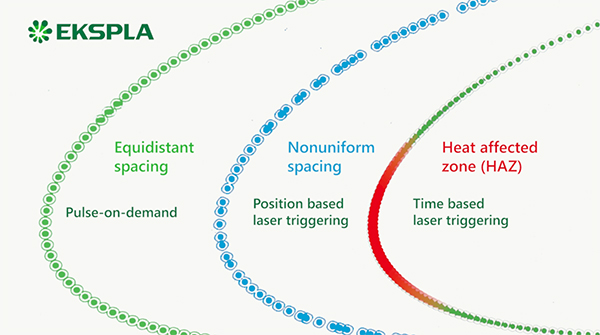
Outline
FemtoLux 30 is a new 30 W femtosecond industrial grade laser build to work 24/7/365 without any interruptions.
■INNOVATIVE COOLING SYSTEM
Other lasers of similar optical power use water for cooling, which means additional bulky and heavy water chiller is needed which require periodical maintenance (cooling system draining and rinsing, water and particle filter replacement). Moreover, in the unfortunate event of water leakage, not only laser head but also more expensive equipment could be damaged. FemtoLux 30 laser uses innovative direct refrigerant cooling (DRC) method that do not contain any water inside the laser head and has much higher cooling efficiency. Laser cooling equipment is integrated together with the power supply unit into a single 4U rack mounted housing with a total weight of just <15 kg.
■PERFECT AND VERSATILE TOOL
To tailor laser for specific applications, FemtoLux 30 laser has a tunable pulse duration from <350 fs to 1 ps and can operate in very broad AOM controlled range of pulse repetition rate from a single shot to 4 MHz. While max energy of >250 µJ, that could be achieved while operating in a burst mode, could ensure higher ablation rates for different materials.
FemtoLux 30 laser is designed as perfect tool for display and microelectronics manufacturing, as well as for micro processing and marking of brittle materials, such as glass, sapphire or ceramics, as well as for highest quality micro processing of different metals and polymers. Innovative laser control electronics ensures easy control of FemtoLux30 laser, thus reducing time and human resources required for integrating this laser into different laser equipment.
While high laser reliability and zero maintenance requirement will assure uninterrupted laser operation and fast ROI to the end user of the laser equipment.
SPECIFICATIONS
- >30 W at 1030 nm, >11 W at 515 nm, >6 W at 343 nm
- >90 µJ at 1030 nm, >55 µJ at 515 nm, >30 µJ at 343 nm
- MHz, GHz, MHz+GHz burst modes
- <350 fs ~ 1 ps
- Single shot to 4 MHz (AOM controlled)
- Dry cooling (no water used)
- <0.5% RMS power long term stability over 100 hours
- <1% RMS pulse energy stability
- M2 < 1.2 (typical < 1.1)
FEATURES
- Zero maintenance
- Dry cooling (no water used)
- Robust and sealed laser head
- PSU and cooling unit integrated into single 4U rack housing
- Easy and quick installation
- Versatile laser control possibility
- Easy drop-in replacement with other lasers
- Compatible with galvo and Polygon scanners as well as PSO controllers
- 2 years of total warranty
APPLICATIONS
- LCD, LED, OLED drilling, cutting and repair
- Microelectronics manufacturing
- Glass, sapphire and ceramics micro processing
- Glass intra volume structuring
- Micro processing of different polymers
- Micro processing of different metals
- Multiphoton imaging
- OPA pumping
Performance
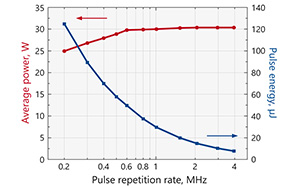
Typical dependence of output power and pulse energy of FemtoLux 30 laser at 1030 nm on pulse repetition rate
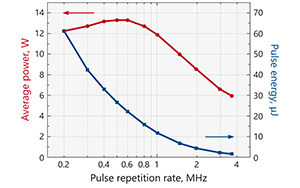
Typical dependence of output power and pulse energy of FemtoLux 30 laser at 515 nm on pulse repetition rate
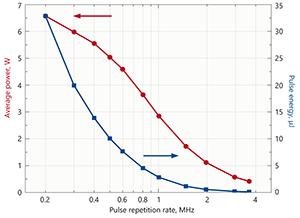
Typical dependence of output power and pulse energy of FemtoLux 30 laser at 343 nm on pulse repetition rate
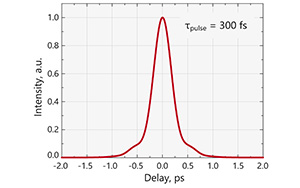
Typical FemtoLux 30 laser (at 1030 nm) output pulse autocorrelation function
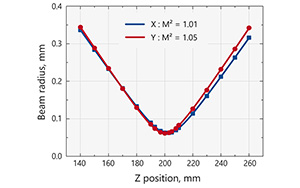
Typical M2 measurement of FemtoLux 30 laser at 1030 nm
Stability
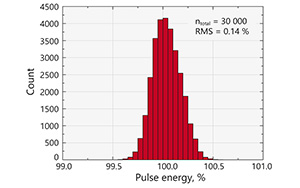
Typical pulse-to-pulse energy stability of FemtoLux 30 laser at 200 kHz over 30 000 pulses. RMS was calculated by using a set of mean values of 10 consecutive laser shots
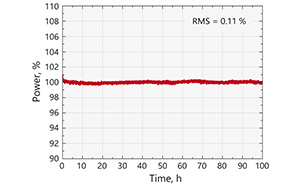
Typical long term average power stability of FemtoLux 30 laser at 1030 nm under constant environmental conditions
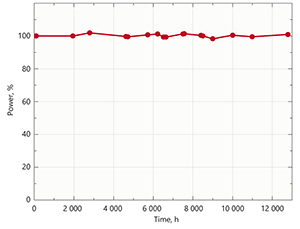
Long-term average power stability of the FemtoLux 30 laser at 1030 nm under constant environmental conditions over an extended duration of 12,000 hours
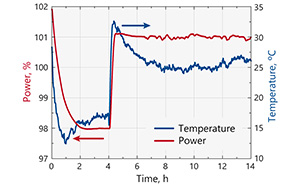
Average output power dependance of FemtoLux 30 laser on ambient temperature at 1030 nm
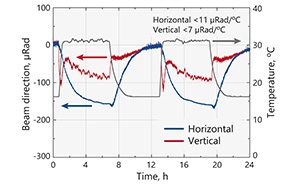
Typical beam direction stability of FemtoLux 30 under harsh environmental conditions
| Model | FemtoLux 30 |
|---|---|
| MAIN SPECIFICATIONS | |
| Central wavelength | |
| Fundamental | 1030 nm |
| With second harmonic option | 515 nm |
| With third harmonic option | 343 nm |
| Pulse Repetition Rate (PRR) | 200 kHz~4 MHz |
| Pulse repetition frequency (PRF) after frequency divider | PRF = PRR / N, N=1, 2, 3, … , 65000; single shot |
| Average output power | |
| At 1030 nm | > 27 W (typical 30 W) |
| At 515 nm | > 11 W |
| At 343 nm | > 6 W |
| Pulse energy | |
| At 1030 nm | > 90 µJ or 1mJ |
| At 515 nm | > 55 µJ |
| At 343 nm | > 30 µJ |
| Number of pulses in MHz burst | 2~10 |
| Total energy in MHz/GHz burst mode | > 250 µJ |
| Power long term stability (Std. dev.) | < 0.5 % |
| Pulse energy stability (Std. dev.) | < 1 % |
| Pulse duration (FWHM) | Tunable, < 350 fs ~ 1 ps |
| Beam quality | M2 < 1.2 (typical < 1.1) |
| Beam circularity, far field | > 0.85 |
| Beam divergence (full angle) | < 1 mrad |
| Beam pointing thermal stability | < 20 µrad/°C |
| Last Updated | Update Information | Size | Download |
|---|


